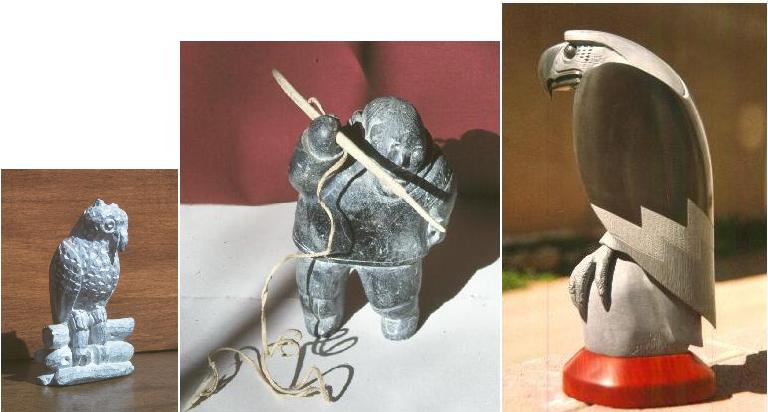( Fr- stéatite [= steatite]; Ger-
Speckstein/Seifenstein; Nor- spekkstein; Rus-
![]() [=
steatite] )
[=
steatite] )
SOAPSTONE (=steatite)

A. Soapstone. Zimbabwe (formerly Rhodesia) carving (height - 8 cm). R.V. Dietrich collection. (© photo by Dick Dietrich)
B. Soapstone. Inuit carving (height - 12.5 cm). R.V. Dietrich collection. (© photo by Dick Dietrich)
C. Soapstone simulant. Pyrophyllite-rich rock, marketed as "South African Wonderstone," eagle (height - ca. 30 cm) sculpted by Dennis R. Christy. Ron Koch collection. (© photo by D.R. Christy)
DESCRIPTION: Soapstone is the name widely
applied to a rock made up largely or wholly of the mineral talc - Mg3Si4O10(OH)2;
some
soapstones are micro- or cryptocrystalline. Properties of talc:
Colors - white, gray, greenish gray, pale
green
-- commonly discolored in reddish or brownish hues and mottled
H. 1 (but, because of the presence of
impurities, effective hardness of
soapstone may range up to 7)
S.G. 2.5-2.8
Light transmission - translucent to
opaque
Luster - waxy to
pearly
Miscellany - feels greasy or
soapy. Some
soapstone contains noteworthy percentages of pyrophyllite, which is
virtually
indistinguishable from talc by macroscopic means. Other relatively
common
constituents of soapstone, which may or may not be macroscopically
discernible,
are chlorite, dolomite, magnesite, tremolite and minor amounts of
oxides
such as magnetite and chromite and even rare sulfides.
OTHER NAMES:
Several other vernacular terms have been given soapstone because of certain appearances and uses -- e.g., bacon stone, grease stone and lard stone and image stone, figure stone and pot stone.
USES: For seals, especially in ancient times; more recently and currently, chiefly carvings --some as objets d'art, others for a variety of utilitarian articles such as soap dishes and incense burners. In addition, I have seen soapstones shaped to resemble beach stones for use as markers -- "Use your permanent paint marker to inscribe the plant's name, ..." for placing in appropriate places in gardens.NOTEWORTHY LOCALITIES: Soapstone occurs in many metamorphic terranes throughout the world. Two well-known sources of soapstone used for carvings (etc.) are the Limbue quarries, near Lake Nyasa, Malawi (formerly Nyasaland) and quarries near Kundla, Gujarat State, Bombay Province, India. Soapstone for Canadian Eskimo carvings has come from the Yukon Territory and Baffin Island. In the western United States, perhaps the best known source of soapstone used for carvings (etc.) is Skagit County, Washington. Quarries near Schulyer, Nelson County, Virginia, which have been a good source of soapstone used for such things as griddles and acid-resistant counter tops and sinks, would appear to constitute a potential source of carving material.
REMARKS: The designation soapstone was apparently applied because the rock tends to feel greasy or soapy.
Soapstone, because it is easily
carved, was sculpted into, for example, busts and fashioned into
seals at least as early as 2550 B.C. Also, soapstone was
early
used for ornaments, tools and diverse containers such as bowls in what
is now the state of Georgia, U.S.A. This latter use, which
antedated use of pottery in the region, was especially important
because the carved soapstone bowls etc. would transmit and
retain heat without breaking and consequently could be used in
cooking. Today, so-called soapstone carving kits, which include
"pre-shaped blocks ... of beautiful Brazilian soapstone," are marketed
for would-be sculptors.
SIMULANTS:
Pyrophyllites- diverse materials consisting largely of pyrophyllite have been given names such agalmatolite, koranna stone and South African wonderstone (see comments re the designation wonderstone that follow the Scenic sandstone listing under the OTHER NAMES subheading in the SANDSTONE entry). Pieces fashioned from this rock, a gemrock in its own right, are usually marketed along with and not distinguished from pieces fashioned from soapstone. Pyrophyllite-rich rocks, many of which are dark gray, slatelike rocks consist largely of pyrophyllite but also contain up to about 10 percent chloritoid or epidote and, in some cases other minerals such as rutile; they have been recovered and used from several localities -- e.g., China, Transvaal (South Africa) and North Carolina. - [likely to require non-macroscopic means].
REFERENCES: No general reference. Indian Bureau of Mines, 1992.
R. V. Dietrich © 2015
Last
update: 26 April 2010
web page created by Emmett Mason